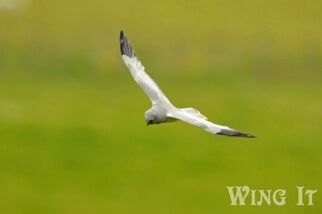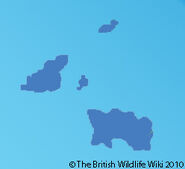
Male Hen Harrier in flight - Stephen Allen
The Hen Harrier (Circus cyaneus) is a bird of prey. It breeds throughout the northern parts of the northern hemisphere.
Description[]
The Hen Harrier is 45–55 cm long with a 97–118 cm wingspan. It resembles other harriers in having distinct male and female plumages. The sexes also differ in weight, with males weighing an average of 350 g and females an average of 530 g.
The male of the nominate race, C. c. cyaneus (Linnaeus, 1766), breeds in Europe and Asia, is mainly grey above and white below except for the upper breast, which is grey like the upperparts, and the rump, which is white; the wings are grey with black wingtips. The female is brown above with white upper tail coverts, hence females, and the similar juveniles, are often called "ringtails". Their underparts are buff streaked with brown.
The female gives a whistled piih-eh when receiving food from the male, and her alarm call is chit-it-it-it-it-et-it. The male calls chek-chek-chek, with a more bouncing chuk-uk-uk-uk during his display flight.
Behaviour[]
This medium-sized raptor breeds on moorland, bogs and (in Europe) farmland. The nest is on the ground. Four to six whitish eggs are laid.
In winter, the Hen Harrier is a bird of open country, and will then roost communally, often with Merlins and Marsh Harriers. This is a typical harrier, with long wings held in a shallow V in its low, contour-hugging, flight. Hen Harriers hunt small mammals and birds, surprising them as they drift low over fields and moors. This harrier tend to be a very vocal bird while it glides over its hunting ground.
Problems in the United Kingdom[]
In the UK, the Hen Harrier suffers illegal persecution by some gamekeepers and their employers on shooting estates, particularly those managed for Red Grouse shooting, resulting in local and regional extinction in many areas, particularly in England where only 20 pairs survive despite abundant suitable habitat capable of holding several hundred pairs. Because of this they are now very rare in many parts of the UK, and under threat in many more areas.
Since the assumed threat to Red Grouse is the main reason for the persecution of this species in the UK, a project funded by Scottish Natural Heritage, the Game & Wildlife Conservation Trust, the RSPB and Natural England was launched at Langholm Moor in Scotland from 2007. The Langholm Moor Demonstration Project (LMDP), a 10-year investigation, costing £3 million, is intended to see whether grouse and raptors can live side-by-side harmoniously.
A similar project, the Joint Raptor Study (also referred to as the 'JRS' or 'the Langholm Study') was run on Langholm from 1992 to 1997. The study made many findings and a host of peer reviewed papers were published on the work, in addition to the final report. Findings suggested that raptor predation at Langholm reduced autumn grouse abundance by 50%, leading to the cessation of driven grouse shooting.. The project ended in 1997, although a follow up supplementary feeding trial was run by the same team in 1998 and 1999. Grouse shooting on the moor was abandoned for the 1998 season onwards.
However, it is important to note that today, the gamekeepers who kill hen harriers and other raptors are in the minority. Incidents of raptor persecution are condemned by almost all other shooters. Several shooting organisations also have policies to expel members who break the law.

